battery TOYOTA AURIS TOURING SPORTS 2016 User Guide
[x] Cancel search | Manufacturer: TOYOTA, Model Year: 2016, Model line: AURIS TOURING SPORTS, Model: TOYOTA AURIS TOURING SPORTS 2016Pages: 660, PDF Size: 17.28 MB
Page 148 of 660
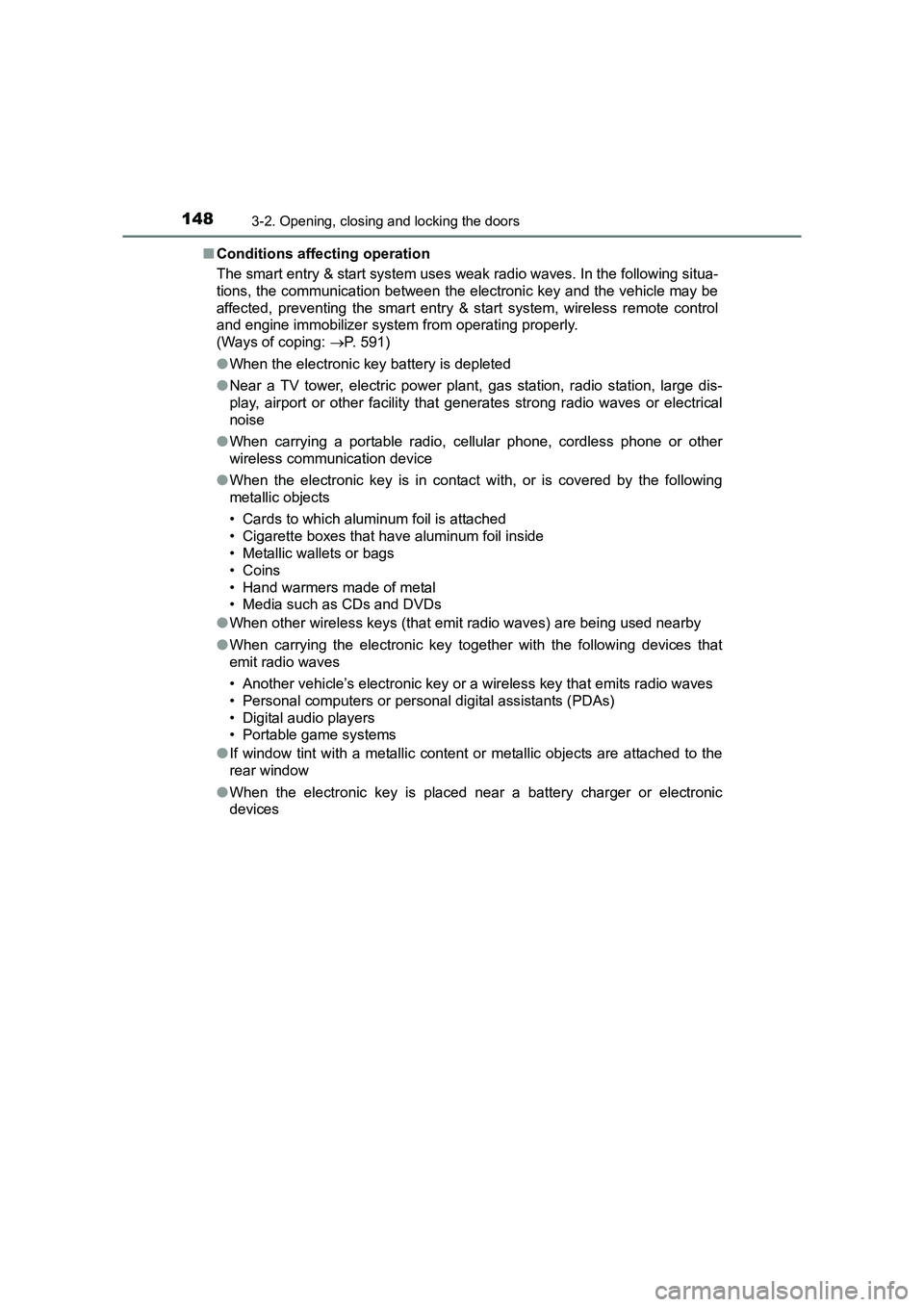
1483-2. Opening, closing and locking the doors
AURIS Touring Sports_EE (12K53E)■
Conditions affecting operation
The smart entry & start system uses weak radio waves. In the following situa-
tions, the communication between the electronic key and the vehicle may be
affected, preventing the smart entry & start system, wireless remote control
and engine immobilizer system from operating properly.
(Ways of coping: →P. 591)
● When the electronic key battery is depleted
● Near a TV tower, electric power plant, gas station, radio station, large dis-
play, airport or other facility that generates strong radio waves or electrical
noise
● When carrying a portable radio, cellular phone, cordless phone or other
wireless communication device
● When the electronic key is in contact with, or is covered by the following
metallic objects
• Cards to which aluminum foil is attached
• Cigarette boxes that have aluminum foil inside
• Metallic wallets or bags
• Coins
• Hand warmers made of metal
• Media such as CDs and DVDs
● When other wireless keys (that emit radio waves) are being used nearby
● When carrying the electronic key together with the following devices that
emit radio waves
• Another vehicle’s electronic key or a wireless key that emits radio waves
• Personal computers or personal digital assistants (PDAs)
• Digital audio players
• Portable game systems
● If window tint with a metallic content or metallic objects are attached to the
rear window
● When the electronic key is placed near a battery charger or electronic
devices
Page 149 of 660
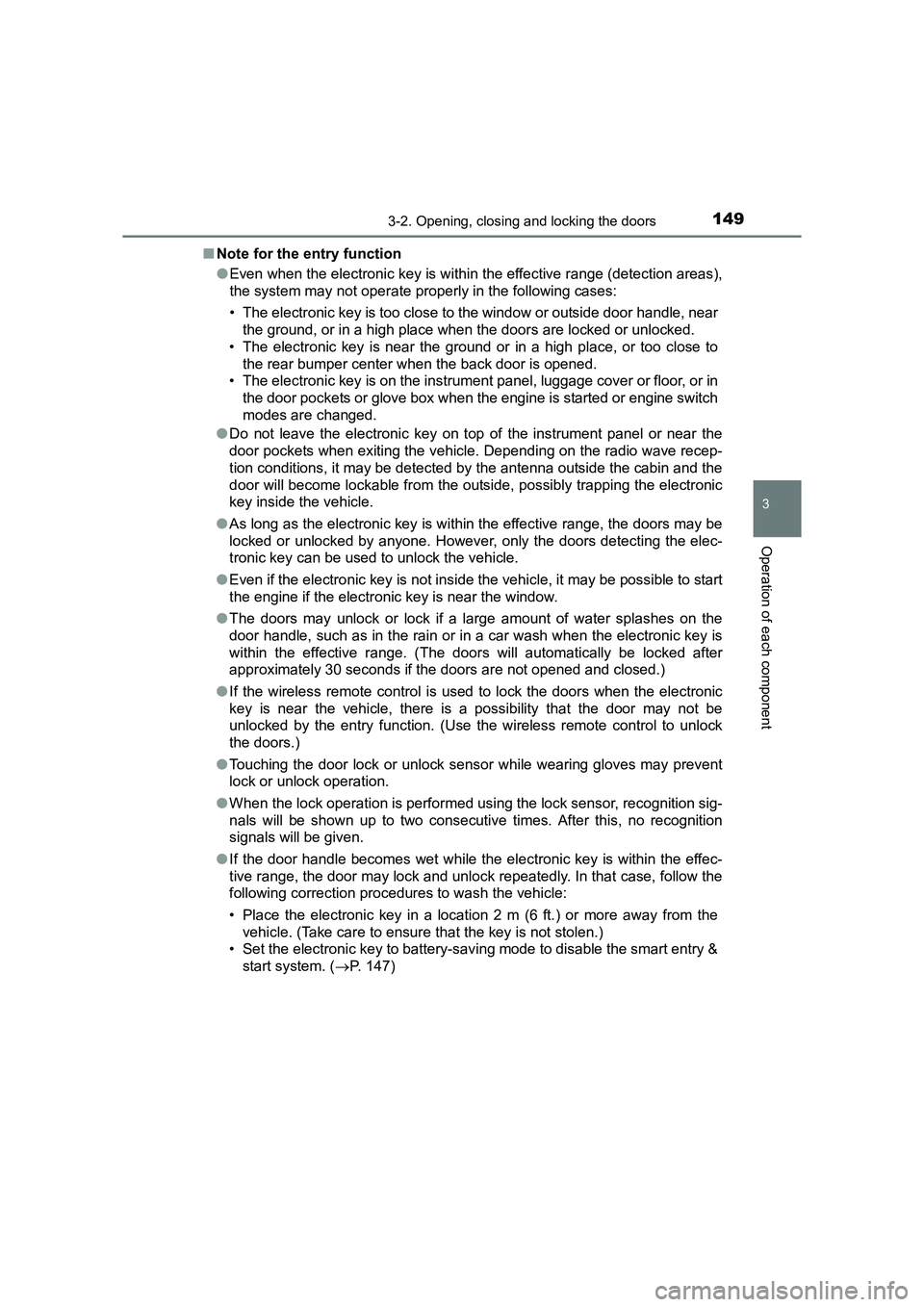
1493-2. Opening, closing and locking the doors
AURIS Touring Sports_EE (12K53E)
3
Operation of each component
■Note for the entry function
●Even when the electronic key is within the effective range (detection areas),
the system may not operate properly in the following cases:
• The electronic key is too close to the window or outside door handle, near
the ground, or in a high place w hen the doors are locked or unlocked.
• The electronic key is near the ground or in a high place, or too close to the rear bumper center when the back door is opened.
• The electronic key is on the instrument panel, luggage cover or floor, or in
the door pockets or glove box when the engine is started or engine switch
modes are changed.
● Do not leave the electronic key on top of the instrument panel or near the
door pockets when exiting the vehicle. Depending on the radio wave recep-
tion conditions, it may be detected by the antenna outside the cabin and the
door will become lockable from the outside, possibly trapping the electronic
key inside the vehicle.
● As long as the electronic key is within the effective range, the doors may be
locked or unlocked by anyone. However, only the doors detecting the elec-
tronic key can be used to unlock the vehicle.
● Even if the electronic key is not inside the vehicle, it may be possible to start
the engine if the electronic key is near the window.
● The doors may unlock or lock if a large amount of water splashes on the
door handle, such as in the rain or in a car wash when the electronic key is
within the effective range. (The doors will automatically be locked after
approximately 30 seconds if the doors are not opened and closed.)
● If the wireless remote control is used to lock the doors when the electronic
key is near the vehicle, there is a possibility that the door may not be
unlocked by the entry function. (Use the wireless remote control to unlock
the doors.)
● Touching the door lock or unlock sens or while wearing gloves may prevent
lock or unlock operation.
● When the lock operation is performed using the lock sensor, recognition sig-
nals will be shown up to two consecutive times. After this, no recognition
signals will be given.
● If the door handle becomes wet while the electronic key is within the effec-
tive range, the door may lock and unlock repeatedly. In that case, follow the
following correction procedures to wash the vehicle:
• Place the electronic key in a location 2 m (6 ft.) or more away from the
vehicle. (Take care to ensure that the key is not stolen.)
• Set the electronic key to battery-saving mode to disable the smart entry &
start system. ( →P. 147)
Page 179 of 660
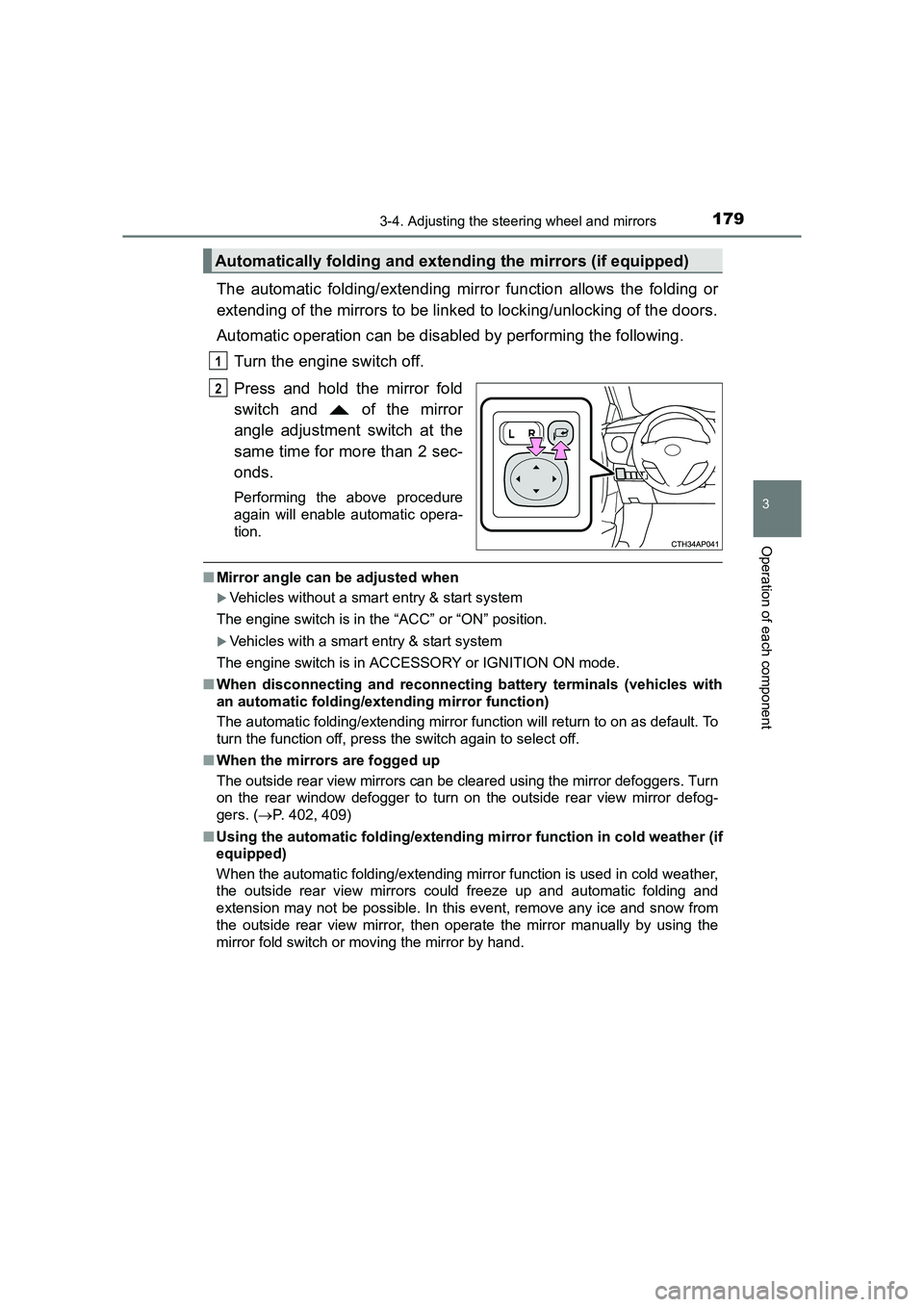
1793-4. Adjusting the steering wheel and mirrors
AURIS Touring Sports_EE (12K53E)
3
Operation of each component
The automatic folding/extending mirror function allows the folding or
extending of the mirrors to be linked to locking/unlocking of the doors.
Automatic operation can be disabled by performing the following.Turn the engine switch off.
Press and hold the mirror fold
switch and of the mirror
angle adjustment switch at the
same time for more than 2 sec-
onds.
Performing the above procedure
again will enable automatic opera-
tion.
■Mirror angle can be adjusted when
�XVehicles without a smart entry & start system
The engine switch is in the “ACC” or “ON” position.
�XVehicles with a smart entry & start system
The engine switch is in ACCESSORY or IGNITION ON mode.
■ When disconnecting and reconnecting battery terminals (vehicles with
an automatic folding/extending mirror function)
The automatic folding/extending mirror function will return to on as default. To
turn the function off, press the switch again to select off.
■ When the mirrors are fogged up
The outside rear view mirrors can be cleared using the mirror defoggers. Turn
on the rear window defogger to turn on the outside rear view mirror defog-
gers. ( →P. 402, 409)
■ Using the automatic folding/extending mirror function in cold weather (if
equipped)
When the automatic folding/extending mirr or function is used in cold weather,
the outside rear view mirrors could freeze up and automatic folding and
extension may not be possible. In this event, remove any ice and snow from
the outside rear view mirror, then operate the mirror manually by using the
mirror fold switch or moving the mirror by hand.
Automatically folding and extending the mirrors (if equipped)
1
2
Page 212 of 660
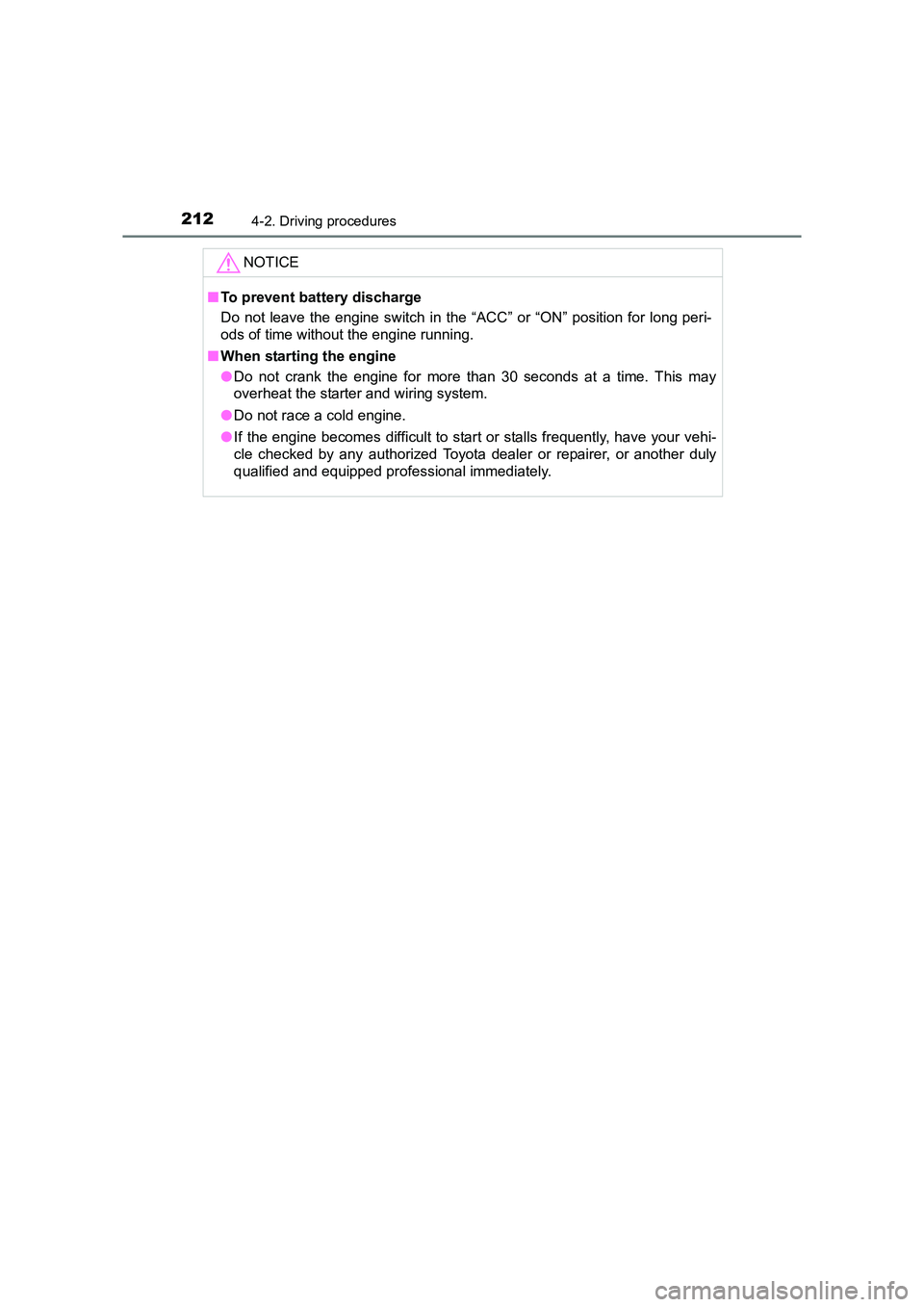
2124-2. Driving procedures
AURIS Touring Sports_EE (12K53E)NOTICE
■
To prevent battery discharge
Do not leave the engine switch in the “ACC” or “ON” position for long peri-
ods of time without the engine running.
■ When starting the engine
●Do not crank the engine for more than 30 seconds at a time. This may
overheat the starter and wiring system.
● Do not race a cold engine.
● If the engine becomes difficult to start or stalls frequently, have your vehi-
cle checked by any authorized Toyota dealer or repairer, or another duly
qualified and equipped professional immediately.
Page 219 of 660
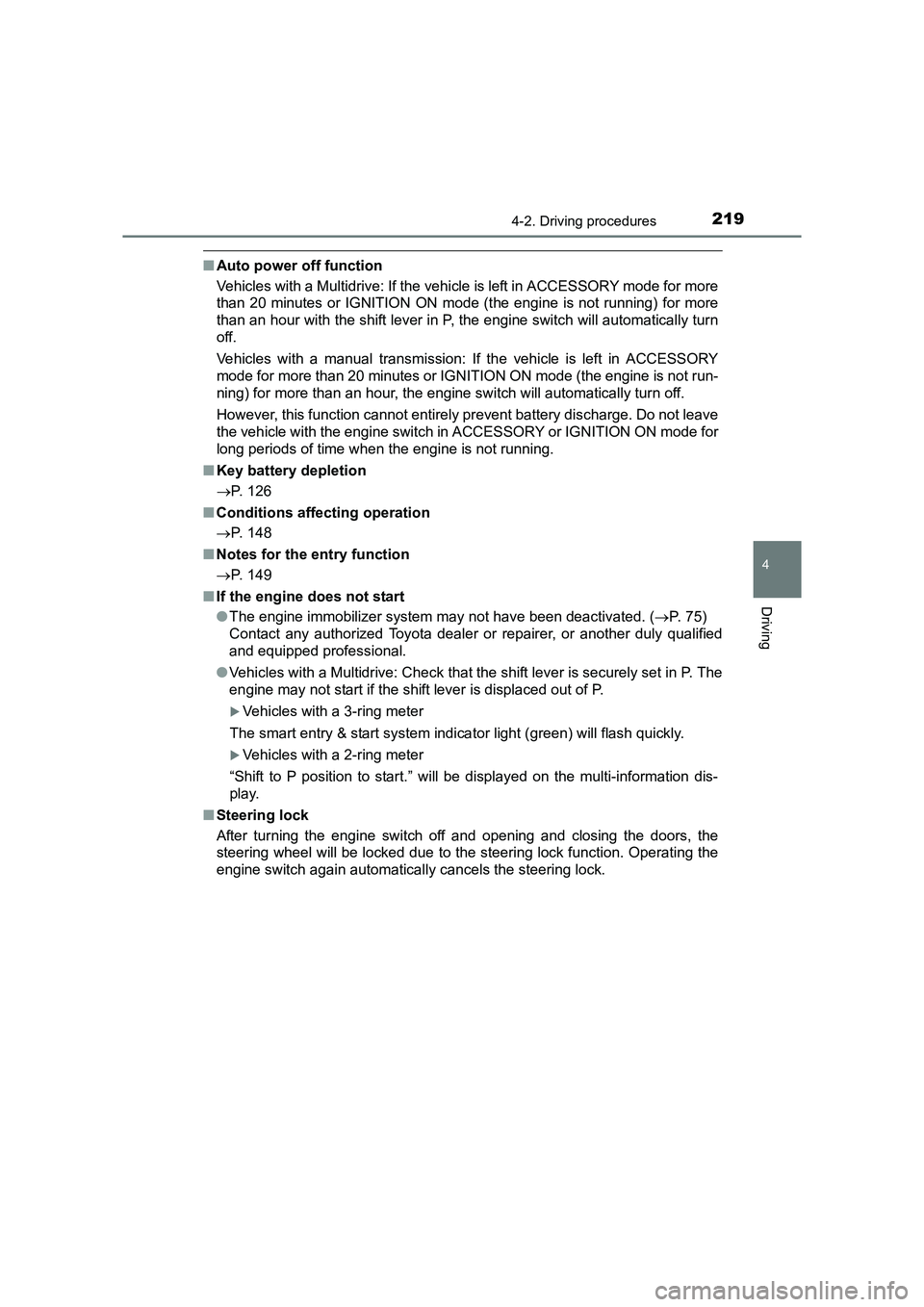
2194-2. Driving procedures
AURIS Touring Sports_EE (12K53E)
4
Driving
■Auto power off function
Vehicles with a Multidrive: If the vehicle is left in ACCESSORY mode for more
than 20 minutes or IGNITION ON mode (the engine is not running) for more
than an hour with the shift lever in P, the engine switch will automatically turn
off.
Vehicles with a manual transmission: If the vehicle is left in ACCESSORY
mode for more than 20 minutes or IGNITION ON mode (the engine is not run-
ning) for more than an hour, the engine switch will automatically turn off.
However, this function cannot entirely prevent battery discharge. Do not leave
the vehicle with the engine switch in ACCESSORY or IGNITION ON mode for
long periods of time when the engine is not running.
■ Key battery depletion
→ P. 126
■ Conditions affecting operation
→ P. 148
■ Notes for the entry function
→ P. 149
■ If the engine does not start
●The engine immobilizer system may not have been deactivated. ( →P. 75)
Contact any authorized Toyota dealer or repairer, or another duly qualified
and equipped professional.
● Vehicles with a Multidrive: Check that the shift lever is securely set in P. The
engine may not start if the shift lever is displaced out of P.
�XVehicles with a 3-ring meter
The smart entry & start system indica tor light (green) will flash quickly.
�XVehicles with a 2-ring meter
“Shift to P position to start.” will be displayed on the multi-information dis-
play.
■ Steering lock
After turning the engine switch off and opening and closing the doors, the
steering wheel will be locked due to the steering lock function. Operating the
engine switch again automatically cancels the steering lock.
Page 220 of 660
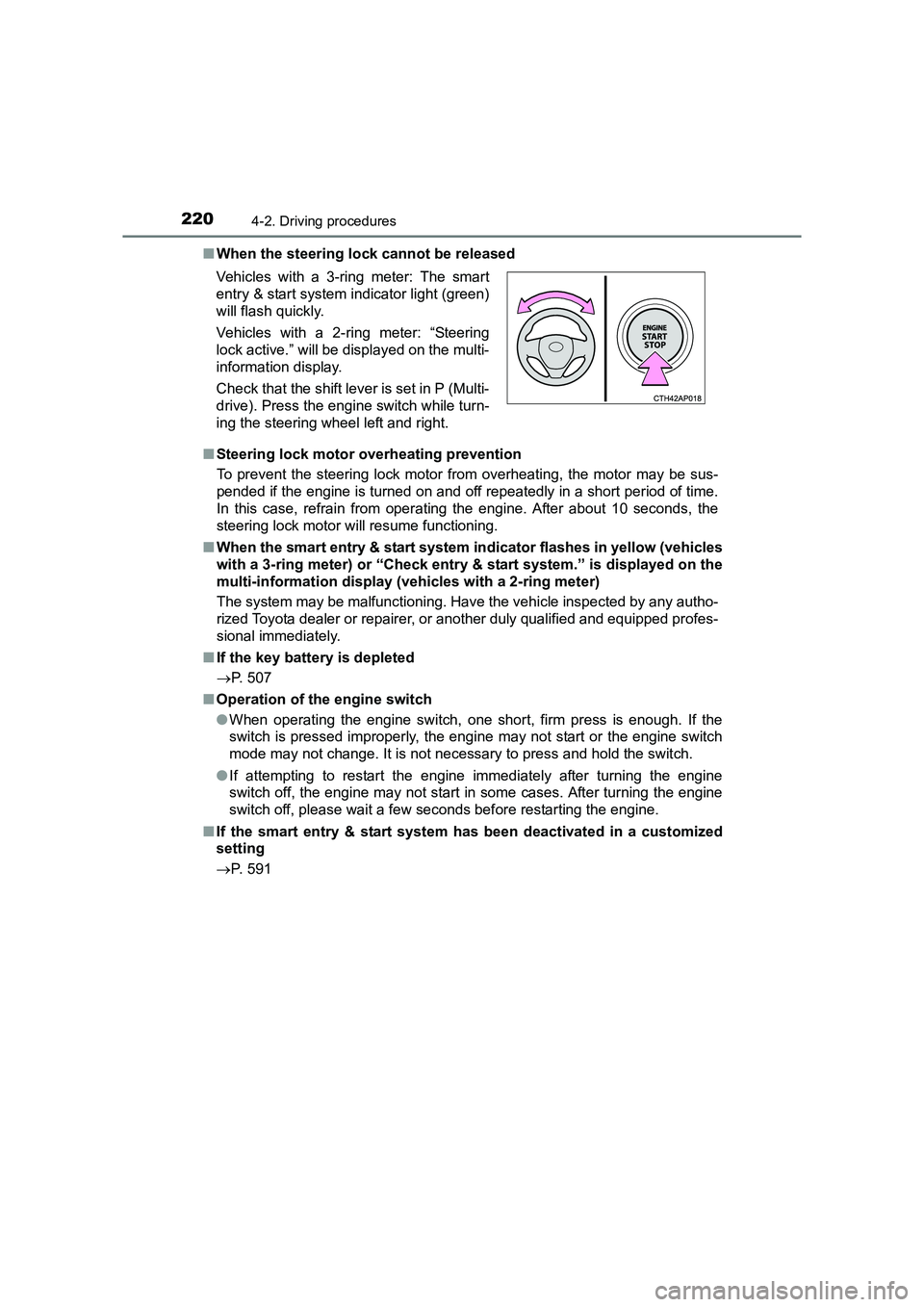
2204-2. Driving procedures
AURIS Touring Sports_EE (12K53E)■
When the steering lock cannot be released
■ Steering lock motor overheating prevention
To prevent the steering lock motor from overheating, the motor may be sus-
pended if the engine is turned on and off repeatedly in a short period of time.
In this case, refrain from operating the engine. After about 10 seconds, the
steering lock motor will resume functioning.
■ When the smart entry & start system indicator flashes in yellow (vehicles
with a 3-ring meter) or “Check entry & start system.” is displayed on the
multi-information display (vehicles with a 2-ring meter)
The system may be malfunctioning. Have the vehicle inspected by any autho-
rized Toyota dealer or repairer, or another duly qualified and equipped profes-
sional immediately.
■ If the key battery is depleted
→ P. 507
■ Operation of the engine switch
●When operating the engine switch, one short, firm press is enough. If the
switch is pressed improperly, the engi ne may not start or the engine switch
mode may not change. It is not necessary to press and hold the switch.
● If attempting to restart the engine i mmediately after turning the engine
switch off, the engine may not start in some cases. After turning the engine
switch off, please wait a few seconds before restarting the engine.
■ If the smart entry & start system h as been deactivated in a customized
setting
→ P. 591
Vehicles with a 3-ring meter: The smart
entry & start system indicator light (green)
will flash quickly.
Vehicles with a 2-ring meter: “Steering
lock active.” will be displayed on the multi-
information display.
Check that the shift lever is set in P (Multi-
drive). Press the engine switch while turn-
ing the steering wheel left and right.
Page 222 of 660
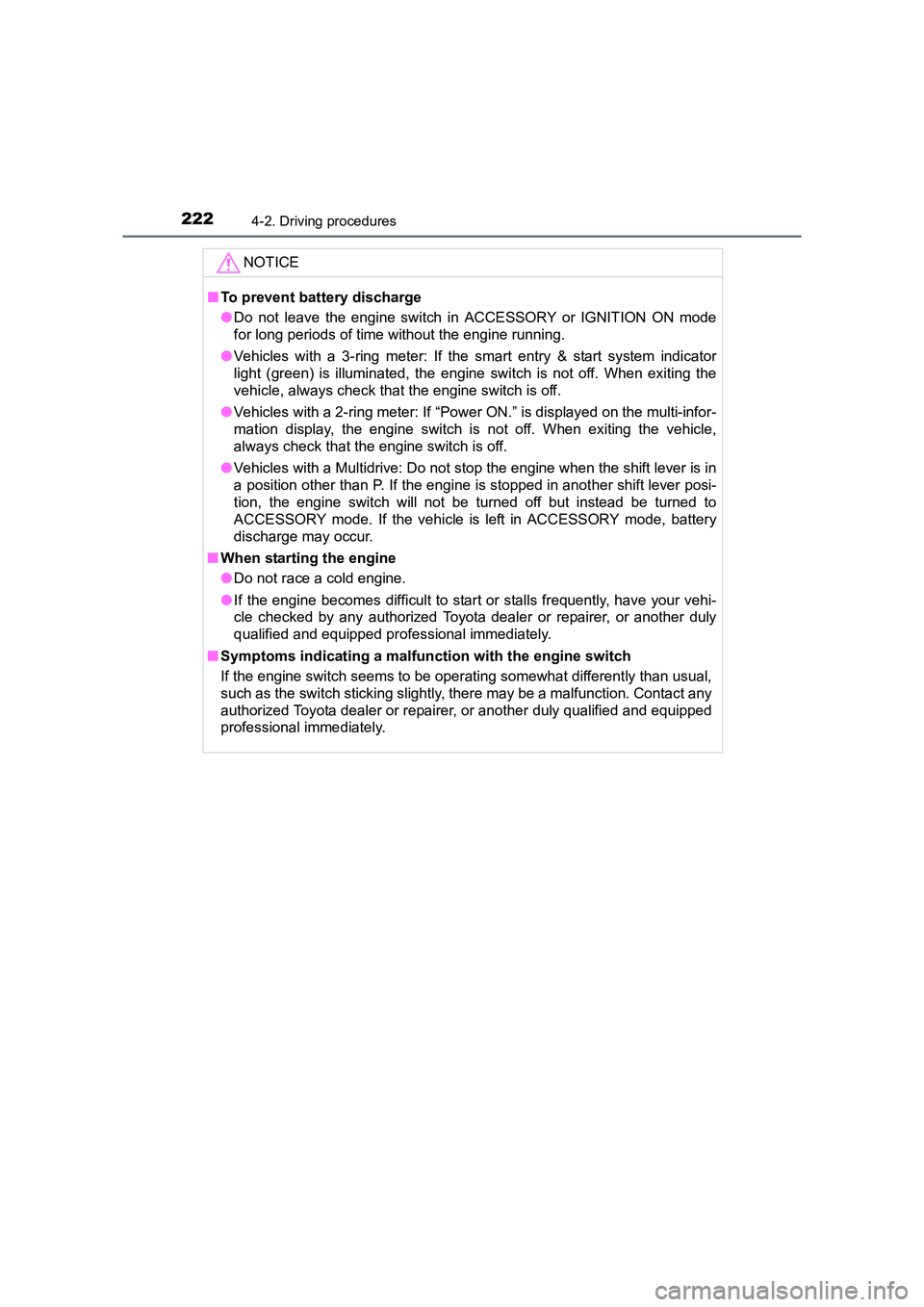
2224-2. Driving procedures
AURIS Touring Sports_EE (12K53E)NOTICE
■
To prevent battery discharge
●Do not leave the engine switch in ACCESSORY or IGNITION ON mode
for long periods of time without the engine running.
● Vehicles with a 3-ring meter: If the smart entry & start system indicator
light (green) is illuminated, the engine switch is not off. When exiting the
vehicle, always check that the engine switch is off.
● Vehicles with a 2-ring meter: If “Power ON.” is displayed on the multi-infor-
mation display, the engine switch is not off. When exiting the vehicle,
always check that the engine switch is off.
● Vehicles with a Multidrive: Do not stop the engine when the shift lever is in
a position other than P. If the engine is stopped in another shift lever posi-
tion, the engine switch will not be turned off but instead be turned to
ACCESSORY mode. If the vehicle is left in ACCESSORY mode, battery
discharge may occur.
■ When starting the engine
●Do not race a cold engine.
● If the engine becomes difficult to start or stalls frequently, have your vehi-
cle checked by any authorized Toyota dealer or repairer, or another duly
qualified and equipped professional immediately.
■ Symptoms indicating a malfunction with the engine switch
If the engine switch seems to be operating somewhat differently than usual,
such as the switch sticking slightly, there may be a malfunction. Contact any
authorized Toyota dealer or repairer, or another duly qualified and equipped
professional immediately.
Page 238 of 660
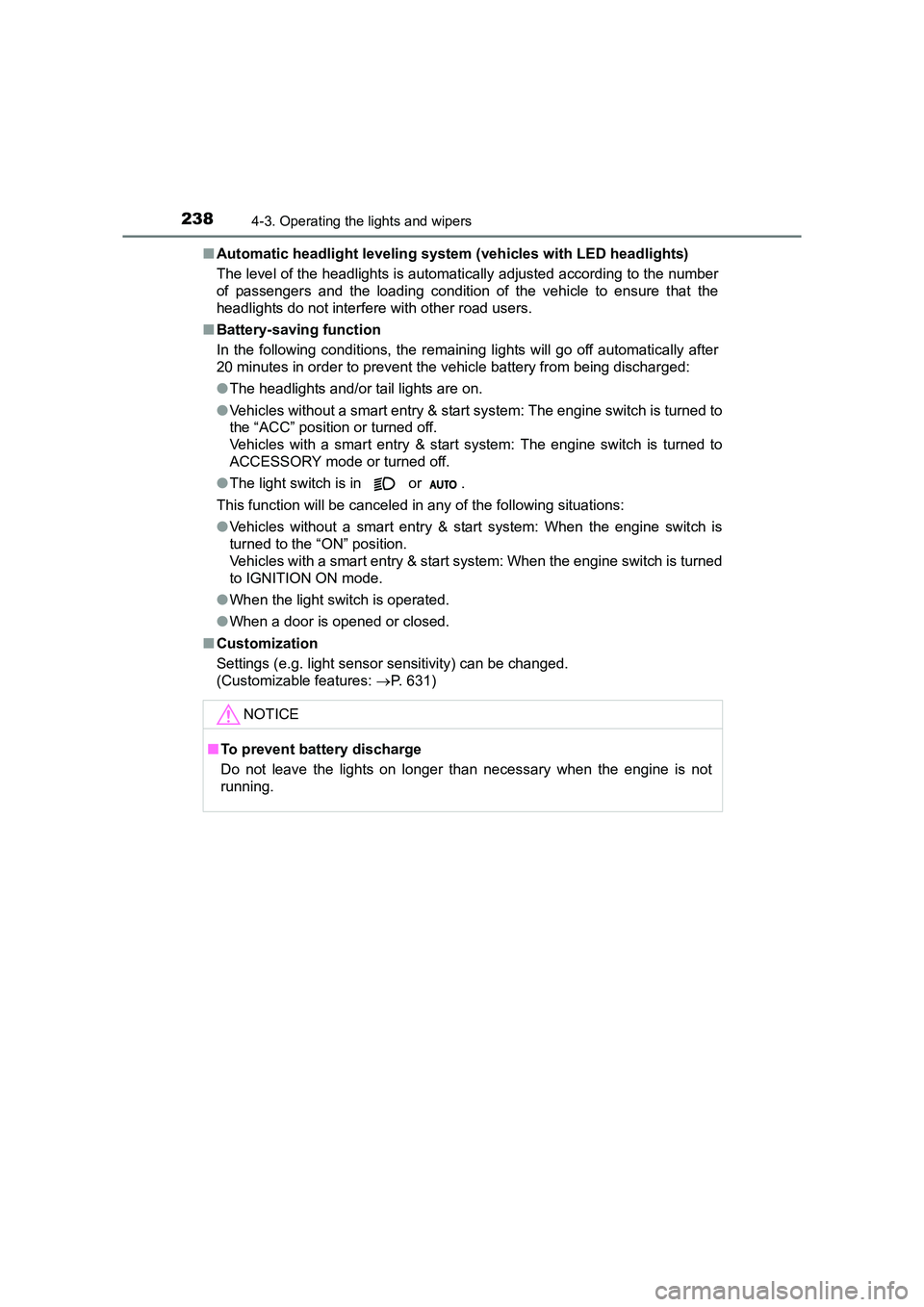
2384-3. Operating the lights and wipers
AURIS Touring Sports_EE (12K53E)■
Automatic headlight leveling system (vehicles with LED headlights)
The level of the headlights is automatically adjusted according to the number
of passengers and the loading condition of the vehicle to ensure that the
headlights do not interfere with other road users.
■ Battery-saving function
In the following conditions, the remaining lights will go off automatically after
20 minutes in order to prevent the vehicle battery from being discharged:
●The headlights and/or tail lights are on.
● Vehicles without a smart entry & start system: The engine switch is turned to
the “ACC” position or turned off.
Vehicles with a smart entry & start system: The engine switch is turned to
ACCESSORY mode or turned off.
● The light switch is in or .
This function will be canceled in any of the following situations:
● Vehicles without a smart entry & start system: When the engine switch is
turned to the “ON” position.
Vehicles with a smart entry & start system: When the engine switch is turned
to IGNITION ON mode.
● When the light switch is operated.
● When a door is opened or closed.
■ Customization
Settings (e.g. light sensor sensitivity) can be changed.
(Customizable features: →P. 631)
NOTICE
■ To prevent battery discharge
Do not leave the lights on longer than necessary when the engine is not
running.
Page 259 of 660
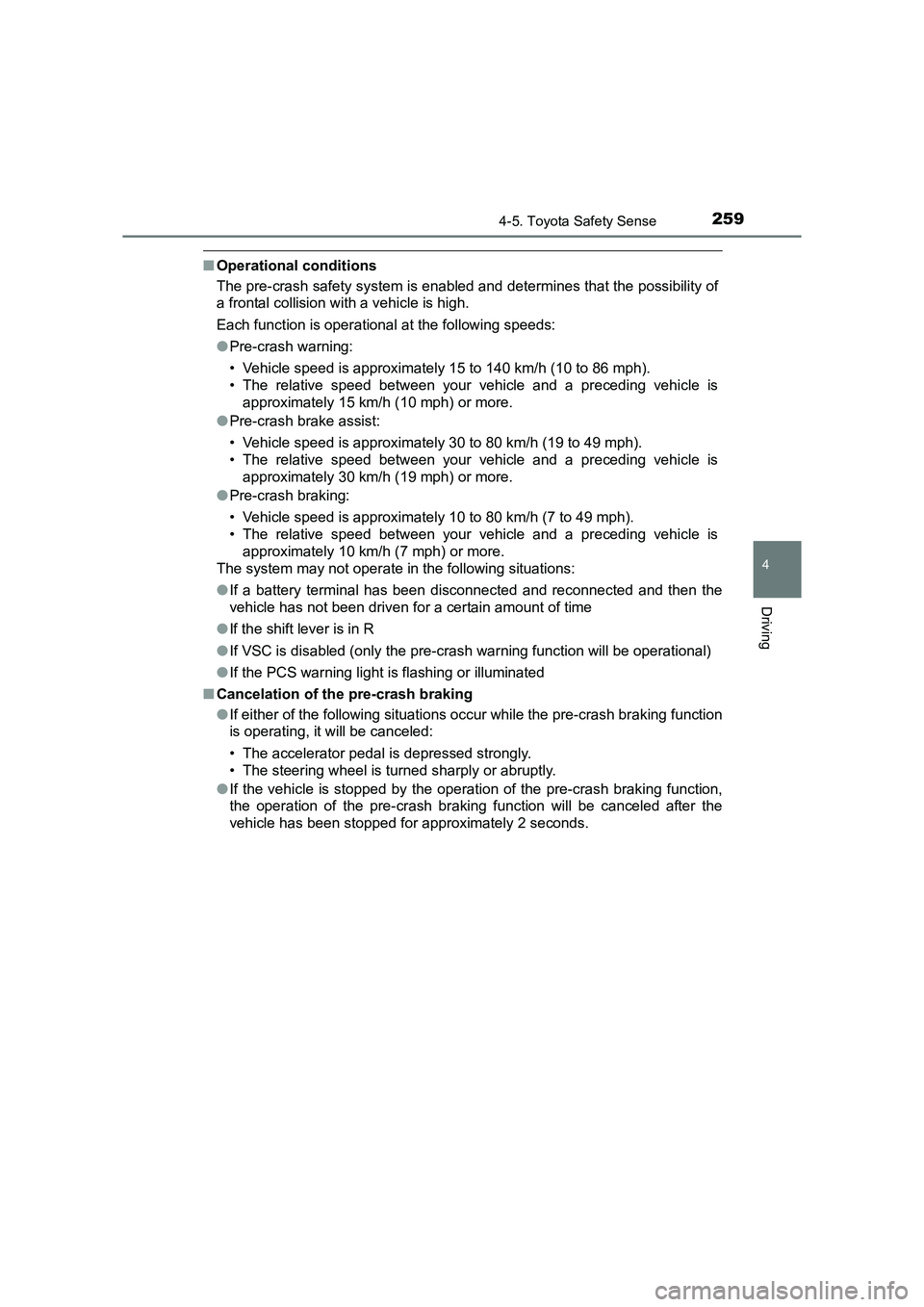
2594-5. Toyota Safety Sense
AURIS Touring Sports_EE (12K53E)
4
Driving
■Operational conditions
The pre-crash safety system is enabled and determines that the possibility of
a frontal collision with a vehicle is high.
Each function is operational at the following speeds:
●Pre-crash warning:
• Vehicle speed is approximately 15 to 140 km/h (10 to 86 mph).
• The relative speed between your vehicle and a preceding vehicle is
approximately 15 km/h (10 mph) or more.
● Pre-crash brake assist:
• Vehicle speed is approximately 30 to 80 km/h (19 to 49 mph).
• The relative speed between your vehicle and a preceding vehicle is
approximately 30 km/h (19 mph) or more.
● Pre-crash braking:
• Vehicle speed is approximately 10 to 80 km/h (7 to 49 mph).
• The relative speed between your vehicle and a preceding vehicle is
approximately 10 km/h (7 mph) or more.
The system may not operate in the following situations:
● If a battery terminal has been disconnected and reconnected and then the
vehicle has not been driven for a certain amount of time
● If the shift lever is in R
● If VSC is disabled (only the pre-crash warning function will be operational)
● If the PCS warning light is flashing or illuminated
■ Cancelation of the pre-crash braking
●If either of the following situations occur while the pre-crash braking function
is operating, it will be canceled:
• The accelerator pedal is depressed strongly.
• The steering wheel is turned sharply or abruptly.
● If the vehicle is stopped by the operation of the pre-crash braking function,
the operation of the pre-crash braking function will be canceled after the
vehicle has been stopped for approximately 2 seconds.
Page 287 of 660
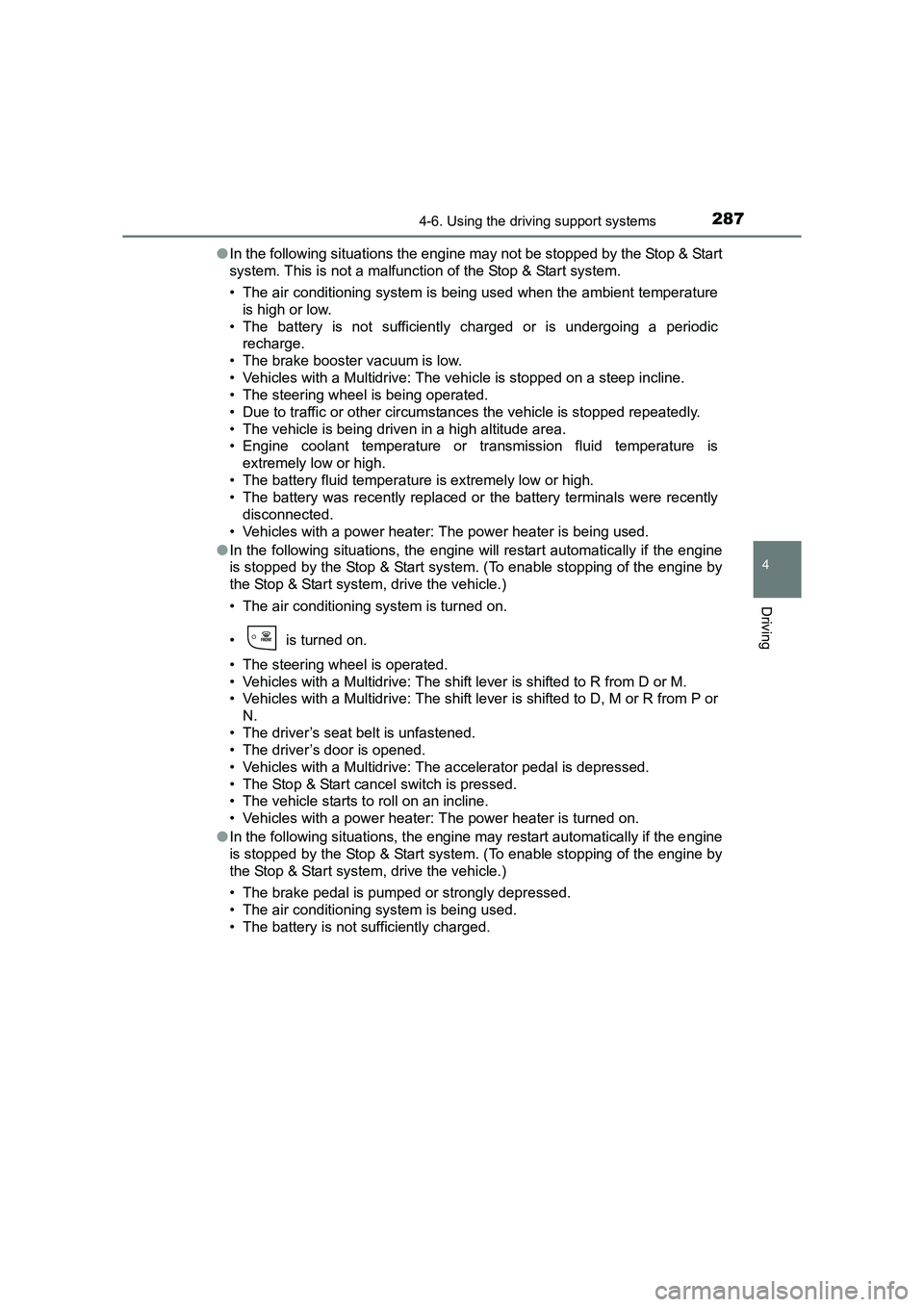
2874-6. Using the driving support systems
AURIS Touring Sports_EE (12K53E)
4
Driving
●In the following situations the engine may not be stopped by the Stop & Start
system. This is not a malfunction of the Stop & Start system.
• The air conditioning system is being used when the ambient temperature
is high or low.
• The battery is not sufficiently charged or is undergoing a periodic recharge.
• The brake booster vacuum is low.
• Vehicles with a Multidrive: The vehicle is stopped on a steep incline.
• The steering wheel is being operated.
• Due to traffic or other circumstances the vehicle is stopped repeatedly.
• The vehicle is being driven in a high altitude area.
• Engine coolant temperature or tr ansmission fluid temperature is
extremely low or high.
• The battery fluid temperature is extremely low or high.
• The battery was recently replaced or the battery terminals were recently
disconnected.
• Vehicles with a power heater: The power heater is being used.
● In the following situations, the engine will restart automatically if the engine
is stopped by the Stop & Start system. (To enable stopping of the engine by
the Stop & Start system, drive the vehicle.)
• The air conditioning system is turned on.
• is turned on.
• The steering wheel is operated.
• Vehicles with a Multidrive: The shift lever is shifted to R from D or M.
• Vehicles with a Multidrive: The shift lever is shifted to D, M or R from P or
N.
• The driver’s seat belt is unfastened.
• The driver’s door is opened.
• Vehicles with a Multidrive: The accelerator pedal is depressed.
• The Stop & Start cancel switch is pressed.
• The vehicle starts to roll on an incline.
• Vehicles with a power heater: The power heater is turned on.
● In the following situations, the engine may restart automatically if the engine
is stopped by the Stop & Start system. (To enable stopping of the engine by
the Stop & Start system, drive the vehicle.)
• The brake pedal is pumped or strongly depressed.
• The air conditioning system is being used.
• The battery is not sufficiently charged.